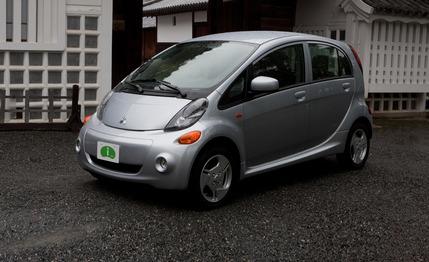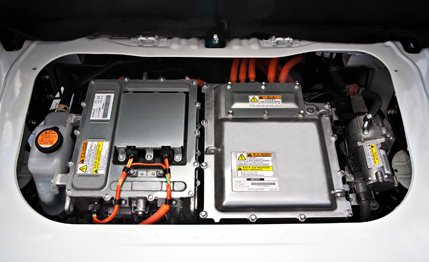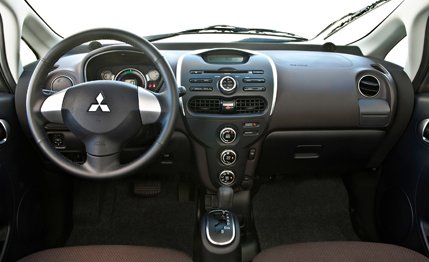
 Instrumented Test
Instrumented Test


It’s easy to confuse weird with bad. The Mitsubishi i is weird. It looks like a computer mouse. It has windshield wipers that resemble Ultraman’s arms in attack mode. It is powered by a 66-hp electric motor mounted under the rear seats. It carries onboard the energy equivalent of less than half a gallon of gas. Its front tires look like compact spares. We could go on. But despite being weird, the i isn’t bad.
To make the tiny electric car (called i-MiEV in the Japanese market) slightly more palatable to American tastes and to allow it to comply with our crash standards, Mitsubishi stretched the Japanese version nearly eight inches and widened it by 4.3 inches. It’s still tiny but now about the same length as a Mini Cooper. The new body’s widened track makes it less likely to be cow tipped. The radically cab-forward, vanlike shape allows four adults to sit within (some touching will be involved). A Nissan Leaf is larger inside and out, but it starts at $36,050. The i opens at a pre–tax-credit price of $29,975; sales started on the West Coast in November, and Mitsubishi plans to offer it nationwide by June. And just to get its new electric car off to a good start in the market, the company will refer to it as the i, but the badge on the car will read “i-MiEV” because, well, Mitsubishi doesn’t appear to have the slightest clue why.
Despite its weirdness, driving the i is unexceptional. It’s slow—0 to 60 takes 13.0 seconds—but there’s nothing abnormal about how it operates. The electric power steering, reportedly tuned by Lancer Evolution engineers, feels surprisingly alive. An electrically powered, vacuum brake booster delivers a firm pedal. The i is relatively light—2552 pounds—but stops from 70 mph in an unremarkable 183 feet, thanks in large part to its low-rolling-resistance tires. The ride is smooth, the structure quiver-free.


Graced with 145 pound-feet of torque but cursed with only 66 horsepower, the 108-pound water-cooled electric motor spins through a single-gear transmission. Below 50 mph, the power—or lack thereof—is tolerable. When merging onto a freeway, you’ll wish for at least 67 horses.
But more power would suck the electrons out of the 16-kWh lithium-ion battery even faster, and the i can go only 62 miles on a full charge, according to the EPA. In the same EPA test, the Leaf returns a 73-mile range.
Mitsubishi says that the i completely depletes and charges its battery. In the interest of battery life (deeply discharging and charging a lithium-ion unit has the potential to shorten its life), many manufacturers don’t use every electron of capacity. Chevy, for example, uses only about 50 percent of the Volt’s battery potential. If battery life is keeping you up at night, the i’s eight-year or 100,000-mile battery warranty might allow you to get some rest. Less likely to soothe is Mitsubishi’s estimate that the pack will have only 80 percent of its original capacity after five years, 70 percent after 10 years. This despite the fact that the battery gets better treatment than the driver. A cooling fan blows air onto the pack when charging temperatures rise, and a battery heater is available as an option for buyers in colder climates since temperature extremes also diminish the battery’s capacity over time. If the driver gets cold while operating the i, Mitsubishi suggests he buck up and use the standard seat heater, which consumes less electricity than the cabin heater.


Recharging an empty battery takes about 22 hours using a 120-volt household outlet. Upgrade to the 240-volt “Level 2” unit that will be sold through Best Buy stores, and the charging time falls to seven hours.
If a range of 62 miles works for your life and you want an electric car, the i delivers. Its weirdness even makes it interesting, or as interesting as a 2552-pound car with 66 horsepower can be.